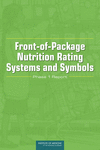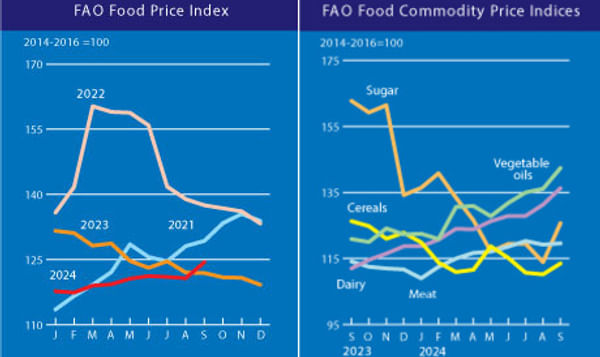Nutrition rating systems and symbols on the fronts of food packaging would be most useful to shoppers if they highlighted four nutrients of greatest concern – calories, saturated fat, trans fat, and sodium – says a new report from the Institute of Medicine. These food components are routinely overconsumed and associated most strongly with diet-related health problems affecting many Americans, including obesity, heart disease, high blood pressure, Type 2 diabetes, and certain types of cancer.
Given the limited space on package fronts and the information already available in the Nutrition Facts panel on the backs of all products, it would not be crucial for these rating systems and symbols to focus on other components, such as cholesterol, fiber, added sugars, or vitamins, concluded the committee that wrote the report.
These findings stem from the committee's review of nutritional criteria behind front-of-package nutrition rating systems and symbols, part of a larger study of these informational tools. A multitude of nutrition rating, or guidance, systems have been developed by food manufacturers, government agencies, nutrition groups, and others in recent years with the intent of helping consumers quickly compare products' nutritional attributes and make healthier choices. Ratings are typically communicated to shoppers through symbols placed prominently on food packaging, usually on the front, or on retail shelf tags. Unlike the Nutrition Facts panel, these rating systems and symbols are unregulated, and different systems focus on different nutrients. The variation may confuse consumers, and questions have been raised about the systems' underlying nutritional criteria.
"Calories, saturated fat, trans fats, and sodium present the most serious diet-related risks to people's health, and many Americans consume far too much of these nutrients,"said committee chair Ellen Wartella, Sheikh Hamad bin Khalifa Al-Thani Professor of Communication, professor of psychology, and director, Center on Media and Human Development, School of Communication, Northwestern University, Evanston, Ill. "As Americans grapple with increasing rates of serious health problems connected to their diets, it's important that the nutritional information they receive is clear, consistent, and well-grounded in nutrition science."
Some organizations and nutrition experts have called for nutrition rating systems to also focus on the sugars added to some products during manufacturing. The committee concurred that both added and naturally occurring sugars contribute to the caloric content of foods and beverages and overconsumption of high-calorie products can lead to obesity. Highlighting calories per serving in nutrition rating systems would address this concern.
The committee will next review research on how consumers understand and use different types of nutritional information and issue a second report recommending ways to optimize the usefulness of front-of-package nutrition rating systems and symbols. This report will also include the committee's assessment of the pros and cons of having a single, standardized front-label food guidance system that is regulated by the Food and Drug Administration.
The report was sponsored by the Centers for Disease Control and Prevention and the U.S. Food and Drug Administration. Established in 1970 under the charter of the National Academy of Sciences, the Institute of Medicine provides independent, objective, evidence-based advice to policymakers, health professionals, the private sector, and the public.
The report (pdf version) can be downloaded free after registration
Given the limited space on package fronts and the information already available in the Nutrition Facts panel on the backs of all products, it would not be crucial for these rating systems and symbols to focus on other components, such as cholesterol, fiber, added sugars, or vitamins, concluded the committee that wrote the report.
These findings stem from the committee's review of nutritional criteria behind front-of-package nutrition rating systems and symbols, part of a larger study of these informational tools. A multitude of nutrition rating, or guidance, systems have been developed by food manufacturers, government agencies, nutrition groups, and others in recent years with the intent of helping consumers quickly compare products' nutritional attributes and make healthier choices. Ratings are typically communicated to shoppers through symbols placed prominently on food packaging, usually on the front, or on retail shelf tags. Unlike the Nutrition Facts panel, these rating systems and symbols are unregulated, and different systems focus on different nutrients. The variation may confuse consumers, and questions have been raised about the systems' underlying nutritional criteria.
"Calories, saturated fat, trans fats, and sodium present the most serious diet-related risks to people's health, and many Americans consume far too much of these nutrients,"said committee chair Ellen Wartella, Sheikh Hamad bin Khalifa Al-Thani Professor of Communication, professor of psychology, and director, Center on Media and Human Development, School of Communication, Northwestern University, Evanston, Ill. "As Americans grapple with increasing rates of serious health problems connected to their diets, it's important that the nutritional information they receive is clear, consistent, and well-grounded in nutrition science."
Some organizations and nutrition experts have called for nutrition rating systems to also focus on the sugars added to some products during manufacturing. The committee concurred that both added and naturally occurring sugars contribute to the caloric content of foods and beverages and overconsumption of high-calorie products can lead to obesity. Highlighting calories per serving in nutrition rating systems would address this concern.
The committee will next review research on how consumers understand and use different types of nutritional information and issue a second report recommending ways to optimize the usefulness of front-of-package nutrition rating systems and symbols. This report will also include the committee's assessment of the pros and cons of having a single, standardized front-label food guidance system that is regulated by the Food and Drug Administration.
The report was sponsored by the Centers for Disease Control and Prevention and the U.S. Food and Drug Administration. Established in 1970 under the charter of the National Academy of Sciences, the Institute of Medicine provides independent, objective, evidence-based advice to policymakers, health professionals, the private sector, and the public.
The report (pdf version) can be downloaded free after registration















